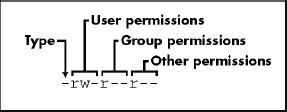File Modes and Permissions
Every Unix file has a set of permissions that determine whether you can read, write, or run the file. Running ls -l displays the permissions. Here's an example of such a display:
-rw-r--r-- 1 juser somegroup 7041 Mar 26 19:34 endnotes.html
The first column represents the mode of the file, and it is shown in bold. The mode represents the file's permissions and some extra information. There are four parts to the mode; Figure 1-1 on the next page illustrates the pieces.

Figure 1-1. The pieces of a file mode
The first character of the mode is the file type. A dash (-) in this position, as in the example, denotes a regular file, ...
Get How Linux Works now with the O’Reilly learning platform.
O’Reilly members experience books, live events, courses curated by job role, and more from O’Reilly and nearly 200 top publishers.

